When a Tornado Strikes: Reflections on Lessons Learned from a Natural Disaster
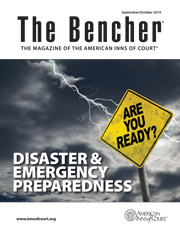 The Bencher—September/October 2019
The Bencher—September/October 2019
By Jamie K. Durrett, Esquire, and Dan L. Nolan, Esquire
In the early morning hours of January 22, 1999, the members of Batson Nolan awoke to terrible news. The firm had just been demolished by a F3 tornado that ripped across Montgomery County, Tennessee, and leveled much of downtown historic Clarksville just after 4 a.m. With winds estimated at 200 miles per hour, the storm devastated businesses and homes, leaving many homeless and many others out of work. The National Weather Service reported that the tornado ripped apart a five-block area of downtown Clarksville and damaged at least 22 buildings at Austin Peay State University. A total of 124 buildings were destroyed, and 562 buildings were damaged. The National Weather Service estimated the damage at $72.7 million. To describe the loss as catastrophic is an understatement
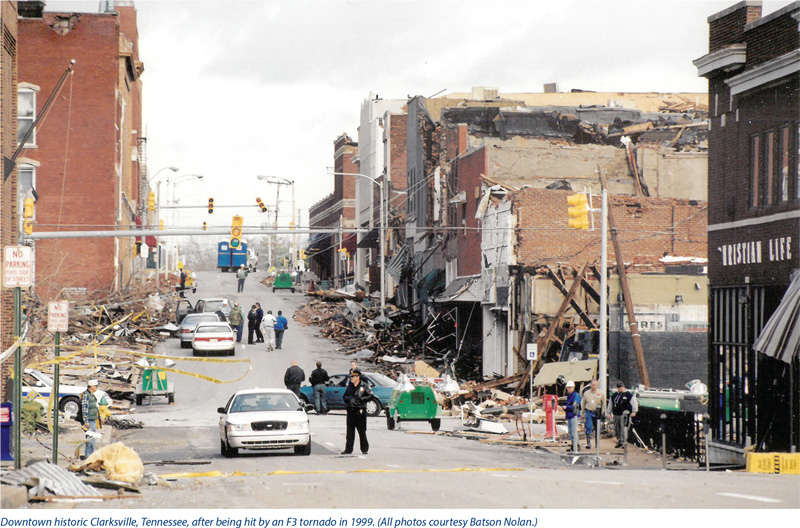
It was estimated that about 75 percent of the lawyers in Clarksville were affected and had to find makeshift locations, such as churches, warehouses, and hotels, to work from. The Montgomery County Courthouse sustained significant damage, which made it impossible to hold court. Batson Nolan was displaced in a temporary office location for four years while construction on its new building was underway. Despite the challenges, Batson Nolan determined that the firm must go on and set to the important work of rebuilding and continuing to provide high-quality legal services. However, the process was not an easy one and was filled with unanticipated challenges, including access to files, lost records, support staff taking other jobs, filing insurance claims, and business disruption. For a time, the practice ground to a complete halt.
When Batson Nolan members arrived downtown to assess the damage, they were denied access to their building because it had been “red-flagged,” which meant temporarily condemned. Half the building was caved in. It had been raining for 24 hours so there was water and debris everywhere. The roof had been removed, and there were holes in the walls and substantial water damage. By the next day, it was deemed safe enough for the members to go in for two hours. The first priority was locating and retrieving client files. We were able to retrieve our file server and an outstanding number of individual computers and hard drives. After several days of staff members, attorneys, and their spouses working tirelessly to dig up whatever they could from the wreckage, the city stopped us from going in because it was a safety hazard.
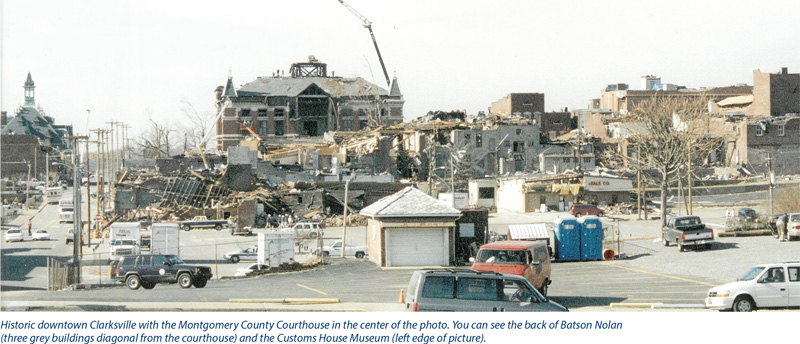
One of the largest challenges was the destruction of client files. There have been many improvements in technology since 1999 that have greatly improved attorneys’ ability to store and retrieve data. But in 1999, we were in the early stages of scanning file materials and years away from storing things on the cloud. Original materials from clients, pleadings, notes from meetings, research, memos—all were gone in a matter of minutes. We were able to find bits and pieces of client materials once we were allowed in what remained of the building, and we had some materials stored on computers that we were able to access through the hard drives. We also depended on other attorneys working on the case to provide materials, if possible.
Though the entire back wall of the courthouse was gone, the general sessions records, chancery records, circuit civil records, juvenile court records, and trial exhibits weren’t destroyed, which helped attorneys move forward with their cases. The Criminal Circuit Court was the hardest hit, and many records were lost. It took a long time and a lot of patience to recreate client files so we could continue representing clients. Eventually, all client files were successfully recovered.
Communication was also difficult. Circuit court judges gave out their home and cell numbers. Attorneys also gave out personal numbers or numbers to their makeshift office spaces to clients and members of the bar. Batson Nolan ran an advertisement in the local newspaper to inform clients of the temporary office location and to let them know we were willing and able to continue assisting them.
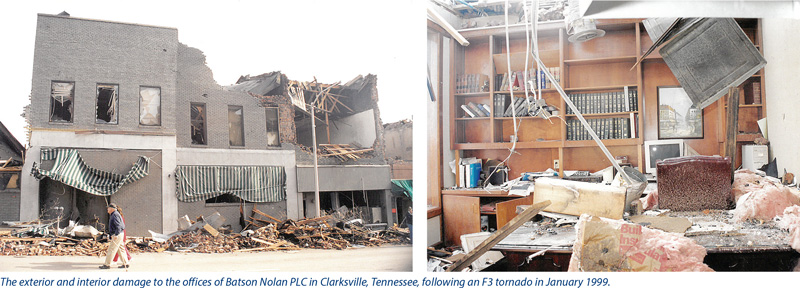
After assessing the damage, we reported the loss to our errors and omissions insurance carrier, which covered our building’s loss and assisted us with building our new space. We also learned the value of business disruption coverage as it allowed us to keep paying our employees. One lesson learned was how to value our loss of business income. As law firms make different amounts of money per month, it was important to demonstrate to the insurance adjuster that the claim could not be based only on the previous month’s income and to negotiate how to value the amount.
Some support staff sought new employment during the recovery phase, which made staffing a challenge. Partners also left the firm after the recovery period. The firm had to replace equipment so staff could perform their job functions. The delay of returning to work for several weeks caused confusion and chaos in moving cases forward and hampered our productivity. Furthermore, many of the materials lost had to be recreated. Attracting support staff was difficult at times as job candidates did not feel secure about the firm’s future.
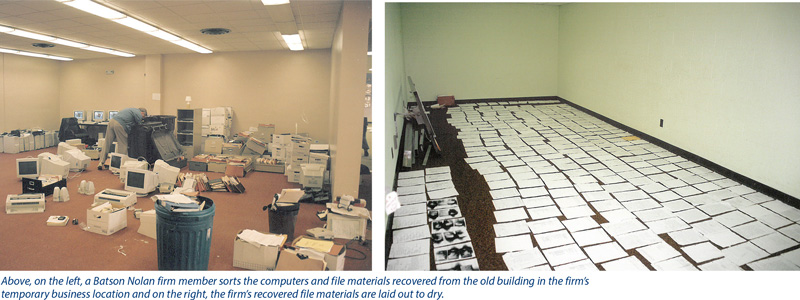
We also learned much about the kindness and quality of the legal community of not only Clarksville and Montgomery County but the state of Tennessee. Many of the attorneys practicing in downtown Clarksville had similar problems and obstacles to overcome and banded together to assist one another, from helping with cleanup to working to set cases in front of judges at alternative sites. Attorneys working through this disaster together treated each other with professionalism and courtesy. They were flexible in providing copies of pleadings and space to hold depositions and meetings, moving deadlines to accommodate the lack of office space or equipment, and offering general support and understanding.
Judges worked on file retrieval and getting the system back up quickly for the public. The Tennessee Bar Association used its online resources to list the temporary addresses of Clarksville lawyers, the court schedule from the Montgomery County Courthouse with the alternative sites, and a listserv where lawyers could list supplies and equipment that they needed or would like to donate. The Clarksville Relief Committee, which was formed by members of the Nashville Bar Association, helped to coordinate efforts to help Montgomery County attorneys. The committee consolidated cash contributions, organized donations of computers and furniture, and organized a volunteer cleanup effort. Other law firms donated time from their technical department professionals to set up computer networks for Clarksville law offices, as well as secretarial support and library resources. People pulled together to support each other. It felt good to have such support after suffering a terrible loss.
It has been 20 years since Batson Nolan PLC and Clarksville experienced this disaster, but it has stayed relevant and present in law firm operations. We routinely discuss disaster preparedness and emergency procedures at the firm. We look for resources and tools to prevent loss and provide security for our clients and employees. There are more resources available than ever before, and disaster preparedness is on everyone’s radar. Local and national bar associations provide checklists and resources to assist firms in recovery, including damage assessment and business continuation procedures, records recovery services contacts, and guidelines on contacting insurance. They revise those guidelines regularly.
We learned just how important it was to be prepared for a natural disaster 20 years ago, and we update our disaster response plan often. You never know what Mother Nature has in store, so here are some tips we have compiled since our natural disaster experience. Whether you are faced with a tornado, flood, earthquake, or fire, it is important to have a written disaster response plan in place that includes:
- evacuation routes,
- who will evacuate persons from the building,
- a list of emergency exits,
- a location to regroup outside the building,
- what emergency equipment and supplies are on-site and where,
- CPR training,
- emergency numbers for personnel, and
- routine inspection by the fire marshal to pinpoint fire hazards.
The disaster response plan should also contemplate business continuity and contain written procedures for communication with employees and clients. You should maintain written contacts for employees and clients maintained both on- and off-site. The plan should determine how and where records and client files are stored, as well as how often and when data backup is performed.
There should also be a plan for the physical plant, equipment, and furnishings should the office be damaged. Determine an alternative location from which your firm could operate on a temporary basis, such as your home, a vacant commercial space, or through arranging a reciprocal agreement with another firm or an alternate branch of your firm. Be familiar with furniture and equipment rental companies in case you need them quickly. Also, review whether your office and computer equipment is adequately protected. You should have a written procedure for shutting down critical computer equipment, locate smoke detection devices near computers, and have supplies on hand to protect equipment from water and debris, such as plastic drop sheets. You should also be familiar with your office and computer equipment leases if the equipment is not owned and what obligations the vendors have in the case of an emergency.
Finally, and most importantly, you must carry insurance for replacement costs of office space, inventory of office equipment, valuable papers, office furnishings, loss of income and extra expenses, business interruption, malpractice for possible missed actions, crime insurance, and fidelity bond. It is critical to routinely review and update your insurance coverage to make sure it accurately covers each item.
While no amount of planning is adequate to completely prepare for a disaster, it can go a long way. We learned hard lessons and endured stress, but through it all we were reminded how fortunate we were to have a place to go home to and the ability to rebuild with the work of our employees, partners, family, friends, and community.
Jamie K. Durrett, Esquire, is an associate of Batson Nolan PLC in Clarksville, Tennessee, and has been a litigation attorney for 12 years. She serves on the board of governors, house of delegates, and Young Lawyers Division of the Tennessee Bar Association and is a Rule 31 Mediator. Dan L. Nolan, Esquire, is a member of Batson Nolan PLC in Clarksville, Tennessee, and has more than 50 years of experience as a trial attorney licensed to practice in Tennessee. He is a past president of the Tennessee Bar Association, a fellow of the American College of Trial Lawyers, and a Rule 31 Mediator.